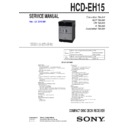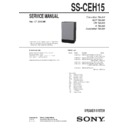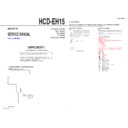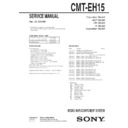Read Sony CMT-EH15 / HCD-EH15 Service Manual online
SERVICE MANUAL
Sony Corporation
Audio&Video Business Group
Published by Sony Techno Create Corporation
HCD-EH15
SPECIFICATIONS
COMPACT DISC DECK RECEIVER
9-889-094-03
2010C05-1
©
2010.03
Canadian Model
AEP Model
UK Model
E Model
Australian Model
Ver. 1.2 2010.03
• HCD-EH15 is the amplifi er, CD player,
tape deck and tuner section in CMT-EH15.
CD
Section
Section
Model Name Using Similar Mechanism
NEW
Base Unit Name
BU-K8BD90-WOD
Optical Pick-up Name
KSM-213CDP
Tape
Section
Section
Model Name Using Similar Mechanism
NEW
Tape Transport Mechanism Type
MF-EH10
Amplifier section
European and Russian models:
DIN power output (rated): 4 + 4 W (4 ohms at 1 kHz, DIN)
Continuous RMS power output (reference): 5 + 5 W (4 ohms at 1 kHz,
10% THD)
Music power output (reference): 7 + 7 W
Continuous RMS power output (reference): 5 + 5 W (4 ohms at 1 kHz,
10% THD)
Music power output (reference): 7 + 7 W
Other models:
DIN power output (rated): 4 + 4 W (4 ohms at 1 kHz, DIN)
Continuous RMS power output (reference): 5 + 5 W (4 ohms at 1 kHz,
10% THD)
Continuous RMS power output (reference): 5 + 5 W (4 ohms at 1 kHz,
10% THD)
Inputs
AUDIO IN (stereo mini jack): Sensitivity 800 mV, impedance 47 kilohms
Outputs
PHONES (stereo mini jack): Accepts headphones with an impedance of
8 ohms or more
SPEAKER: Accepts impedance of 4 ohms
8 ohms or more
SPEAKER: Accepts impedance of 4 ohms
CD player section
System: Compact disc and digital audio system
Laser Diode Properties
Laser Diode Properties
Emission Duration: Continuous
Laser Output*: Less than 44.6μW
* This output is the value measurement at a distance of 200 mm from the
Laser Output*: Less than 44.6μW
* This output is the value measurement at a distance of 200 mm from the
objective lens surface on the Optical Pick-up Block with 7 mm aperture.
Frequency response: 20 Hz 20 kHz
Signal-to-noise ratio: More than 90 dB
Dynamic range: More than 90 dB
Signal-to-noise ratio: More than 90 dB
Dynamic range: More than 90 dB
Tape deck section
Recording system: 4-track 2-channel, stereo
Tuner section
FM stereo, FM/AM superheterodyne tuner
Antenna:
Antenna:
FM lead antenna
AM loop antenna
AM loop antenna
FM tuner section:
Tuning range
Canadian model: 87.5 108.0 MHz (100 kHz step)
Other models: 87.5 108.0 MHz (50 kHz step)
Intermediate frequency: 10.7 MHz
Canadian model: 87.5 108.0 MHz (100 kHz step)
Other models: 87.5 108.0 MHz (50 kHz step)
Intermediate frequency: 10.7 MHz
AM tuner section:
Tuning range
Canadian and Latin American models:
530 1,710 kHz (with 10 kHz tuning interval)
531 1,710 kHz (with 9 kHz tuning interval)
European and Russian models:
531 1,602 kHz (with 9 kHz tuning interval)
Australian model:
531 1,710 kHz (with 9 kHz tuning interval)
530 1,710 kHz (with 10 kHz tuning interval)
Other models:
531 1,602 kHz (with 9 kHz tuning interval)
530 1,610 kHz (with 10 kHz tuning interval)
Intermediate frequency: 450 kHz
Canadian and Latin American models:
530 1,710 kHz (with 10 kHz tuning interval)
531 1,710 kHz (with 9 kHz tuning interval)
European and Russian models:
531 1,602 kHz (with 9 kHz tuning interval)
Australian model:
531 1,710 kHz (with 9 kHz tuning interval)
530 1,710 kHz (with 10 kHz tuning interval)
Other models:
531 1,602 kHz (with 9 kHz tuning interval)
530 1,610 kHz (with 10 kHz tuning interval)
Intermediate frequency: 450 kHz
General
Power requirements:
Canadian model: AC 120 V, 60 Hz
Eu
Mexican model: AC 120 V, 60 Hz
ropean and Russian models: AC 230 V, 50/60 Hz
Australian model: AC 230 240 V, 50/60 Hz
Argentine and Thai models: AC 220 V, 50/60 Hz
Brazilian model: AC 127 or 220 V, 50/60 Hz
Korean model: AC 220 V, 60 Hz
Taiwan model: AC 120 V, 50/60 Hz
Other models: AC 110 120 or 220 240 V, 50/60 Hz
Adjustable with voltage selector
Argentine and Thai models: AC 220 V, 50/60 Hz
Brazilian model: AC 127 or 220 V, 50/60 Hz
Korean model: AC 220 V, 60 Hz
Taiwan model: AC 120 V, 50/60 Hz
Other models: AC 110 120 or 220 240 V, 50/60 Hz
Adjustable with voltage selector
Power consumption: 25 W
Dimensions (w/h/d) (excl. speakers): Approx. 155 × 241 × 224.6 mm
Mass (excl. speakers): Approx. 2.2 kg
Dimensions (w/h/d) (excl. speakers): Approx. 155 × 241 × 224.6 mm
Mass (excl. speakers): Approx. 2.2 kg
Design and specifications are subject to change without notice.
HCD-EH15
2
1.
SERVICING NOTES
.............................................
3
2. GENERAL
..................................................................
4
3. DISASSEMBLY
3-1. Disassembly
Flow
........................................................... 6
3-2. Rear Cabinet Block ......................................................... 6
3-3. Front Cabinet Block, Top Cabinet Block,
MAIN
3-3. Front Cabinet Block, Top Cabinet Block,
MAIN
Board
...................................................................
7
3-4. MF-EH10 (Tape Mechanism Deck), Cassette Lid .......... 7
3-5. Base Unit Block (BU-K8BD90-WOD) .......................... 8
3-6. Optical Pick-up Block (KSM-213CDP) ......................... 8
3-5. Base Unit Block (BU-K8BD90-WOD) .......................... 8
3-6. Optical Pick-up Block (KSM-213CDP) ......................... 8
4.
TEST MODE
............................................................
9
5. MECHANICAL
ADJUSTMENTS
...................... 10
6. ELECTRICAL
ADJUSTMENTS
........................ 10
7. DIAGRAMS
7-1. Printed Wiring Board - CD Board - ................................ 14
7-2. Schematic Diagram - CD Board - ................................... 15
7-3. Printed Wiring Board - PANEL Board - ......................... 16
7-4. Schematic Diagram - PANEL Board - ............................ 17
7-5. Schematic Diagram - MAIN Section (1/2) - ................... 18
7-6. Schematic Diagram - MAIN Section (2/2) - ................... 19
7-7. Printed Wiring Boards - MAIN Section - ....................... 20
7-2. Schematic Diagram - CD Board - ................................... 15
7-3. Printed Wiring Board - PANEL Board - ......................... 16
7-4. Schematic Diagram - PANEL Board - ............................ 17
7-5. Schematic Diagram - MAIN Section (1/2) - ................... 18
7-6. Schematic Diagram - MAIN Section (2/2) - ................... 19
7-7. Printed Wiring Boards - MAIN Section - ....................... 20
8.
EXPLODED VIEWS
8-1. Overall
Section
............................................................... 27
8-2. Front Cabinet Section ..................................................... 28
8-3. Top Cabinet Section ........................................................ 29
8-4. Base Unit Section (BU-K8BD90-WOD) ........................ 30
8-3. Top Cabinet Section ........................................................ 29
8-4. Base Unit Section (BU-K8BD90-WOD) ........................ 30
9.
ELECTRICAL PARTS LIST
.............................. 31
Note: Refer to supplement-1 for the MAIN board of printed wiring
board, schematic diagram and electrical parts list of AEP,
Brazilian and Thai models.
Brazilian and Thai models.
TABLE OF CONTENTS
Notes on chip component replacement
•
•
Never reuse a disconnected chip component.
•
Notice that the minus side of a tantalum capacitor may be dam-
aged by heat.
aged by heat.
This appliance is classified
as a CLASS 1 LASER
product. This marking
is located on the rear
exterior.
as a CLASS 1 LASER
product. This marking
is located on the rear
exterior.
Ver. 1.2
SAFETY-RELATED COMPONENT WARNING!
COMPONENTS IDENTIFIED BY MARK
0 OR DOTTED LINE
WITH MARK
0 ON THE SCHEMATIC DIAGRAMS AND IN
THE PARTS LIST ARE CRITICAL TO SAFE OPERATION.
REPLACE THESE COMPONENTS WITH SONY PARTS
REPLACE THESE COMPONENTS WITH SONY PARTS
WHOSE PART NUMBERS APPEAR AS SHOWN IN THIS
MANUAL OR IN SUPPLEMENTS PUBLISHED BY SONY.
MANUAL OR IN SUPPLEMENTS PUBLISHED BY SONY.
ATTENTION AU COMPOSANT AYANT RAPPORT
À LA SÉCURITÉ!
LES COMPOSANTS IDENTIFIÉS PAR UNE MARQUE
0 SUR
LES DIAGRAMMES SCHÉMATIQUES ET LA LISTE DES
PIÈCES SONT CRITIQUES POUR LA SÉCURITÉ DE FONC-
TIONNEMENT. NE REMPLACER CES COMPOSANTS QUE
PAR DES PIÈCES SONY DONT LES NUMÉROS SONT DON-
NÉS DANS CE MANUEL OU DANS LES SUPPLÉMENTS
PUBLIÉS PAR SONY.
PIÈCES SONT CRITIQUES POUR LA SÉCURITÉ DE FONC-
TIONNEMENT. NE REMPLACER CES COMPOSANTS QUE
PAR DES PIÈCES SONY DONT LES NUMÉROS SONT DON-
NÉS DANS CE MANUEL OU DANS LES SUPPLÉMENTS
PUBLIÉS PAR SONY.
CAUTION
Use of controls or adjustments or performance of procedures other than
those specifi ed herein may result in hazardous radiation exposure.
Use of controls or adjustments or performance of procedures other than
those specifi ed herein may result in hazardous radiation exposure.
HCD-EH15
3
SECTION 1
SERVICING NOTES
UNLEADED SOLDER
Boards requiring use of unleaded solder are printed with the lead-
free mark (LF) indicating the solder contains no lead.
(Caution: Some printed circuit boards may not come printed with
Boards requiring use of unleaded solder are printed with the lead-
free mark (LF) indicating the solder contains no lead.
(Caution: Some printed circuit boards may not come printed with
the lead free mark due to their particular size)
: LEAD FREE MARK
Unleaded solder has the following characteristics.
• Unleaded solder melts at a temperature about 40 °C higher
• Unleaded solder melts at a temperature about 40 °C higher
than ordinary solder.
Ordinary soldering irons can be used but the iron tip has to be
applied to the solder joint for a slightly longer time.
applied to the solder joint for a slightly longer time.
Soldering irons using a temperature regulator should be set to
about 350 °C.
Caution: The printed pattern (copper foil) may peel away if the
about 350 °C.
Caution: The printed pattern (copper foil) may peel away if the
heated tip is applied for too long, so be careful!
• Strong
viscosity
Unleaded solder is more viscous (sticky, less prone to fl ow)
than ordinary solder so use caution not to let solder bridges
occur such as on IC pins, etc.
than ordinary solder so use caution not to let solder bridges
occur such as on IC pins, etc.
• Usable with ordinary solder
It is best to use only unleaded solder but unleaded solder may
also be added to ordinary solder.
also be added to ordinary solder.
NOTES ON HANDLING THE OPTICAL PICK-UP
BLOCK OR BASE UNIT
BLOCK OR BASE UNIT
The laser diode in the optical pick-up block may suffer electro-
static break-down because of the potential difference generated by
the charged electrostatic load, etc. on clothing and the human body.
During repair, pay attention to electrostatic break-down and also
use the procedure in the printed matter which is included in the
repair parts.
The fl exible board is easily damaged and should be handled with
care.
static break-down because of the potential difference generated by
the charged electrostatic load, etc. on clothing and the human body.
During repair, pay attention to electrostatic break-down and also
use the procedure in the printed matter which is included in the
repair parts.
The fl exible board is easily damaged and should be handled with
care.
NOTES ON LASER DIODE EMISSION CHECK
The laser beam on this model is concentrated so as to be focused
on the disc refl ective surface by the objective lens in the optical
pickup block. Therefore, when checking the laser diode emission,
observe from more than 30 cm away from the objective lens.
The laser beam on this model is concentrated so as to be focused
on the disc refl ective surface by the objective lens in the optical
pickup block. Therefore, when checking the laser diode emission,
observe from more than 30 cm away from the objective lens.
LASER DIODE AND FOCUS SEARCH OPERATION
CHECK
During normal operation of the equipment, emission of the laser
diode is prohibited unless the upper lid is closed while turning on
the SW750. (push switch type)
The following checking method for the laser diode is operable.
• Method
Emission of the laser diode is visually checked.
1. Open the upper lid.
2. Push the SW750 as shown in Fig.1.
CHECK
During normal operation of the equipment, emission of the laser
diode is prohibited unless the upper lid is closed while turning on
the SW750. (push switch type)
The following checking method for the laser diode is operable.
• Method
Emission of the laser diode is visually checked.
1. Open the upper lid.
2. Push the SW750 as shown in Fig.1.
Note: Do not push the detection lever strongly, or it may be bent or
damaged.
3. Check the object lens for confi rming normal emission of the
laser diode. If not emitting, there is a trouble in the automatic
power control circuit or the optical pick-up.
power control circuit or the optical pick-up.
In this operation, the object lens will move up and down 2
times along with inward motion for the focus search.
SW750
Fig. 1. Method to push the SW750
MODEL IDENTIFICATION
Ver. 1.2
Model
POWER VOLTAGE INDICATION
Canadian and Mexican
models
models
AC 120 V, 60 Hz
AEP, Russian and UK
models
models
AC 230 V, 50/60 Hz
Australian model
AC 230 – 240 V, 50/60 Hz
Argentina and Thai
models
models
AC 220 V, 50/60 Hz
Korean model
AC 220 V, 60 Hz
Taiwan model
AC 120 V, 50/60 Hz
Singapore, Chilean and
Peruvian models
Peruvian models
AC 110 – 120 or 220 – 240 V,
50/60 Hz
50/60 Hz
Brazilian model
AC 127 or 220 V, 50/60 Hz
Power Voltage
Indication
Indication
– Rear Cabinet –
HCD-EH15
4
SECTION 2
GENERAL
This section is extracted
from instruction manual.
from instruction manual.
Basic Operations
Open the tape
section lid.
section lid.
This manual mainly explains operations using the
remote, but the same operations can also be performed
using the buttons on the unit having the same or similar
names.
remote, but the same operations can also be performed
using the buttons on the unit having the same or similar
names.
Before using the system
To use the remote
Slide and remove the battery compartment lid
, and
insert the two R6 (size AA) batteries (not supplied),
side first, matching the polarities shown below.
Notes on using the remote
With normal use, the batteries should last for about six months.
Do not mix an old battery with a new one or mix different types of
batteries.
If you do not use the remote for a long period of time, remove the
batteries to avoid damage from battery leakage and corrosion.
To set the clock
Use buttons on the remote to set the clock.
1
Turn on the system.
Press
(on/standby)
.
2
Select the clock set mode.
Press CLOCK/TIMER SET
. If the current mode
appears, press
/
repeatedly to select
“CLOCK,” and then press ENTER
.
3
Set the time.
Press
/
repeatedly to set the hour, and
then press ENTER
. Use the same procedure to set
the minutes.
The clock settings are lost when you disconnect the
power cord or if a power failure occurs.
The clock settings are lost when you disconnect the
power cord or if a power failure occurs.
Selecting a music source
Press the following buttons (or press FUNCTION
repeatedly).
To select
Press
CD
CD
.
Tuner
TUNER/BAND
.
Tape
FUNCTION
repeatedly until “TAPE”
appears.
appears.
Component* (connected
using an audio cord)
using an audio cord)
AUDIO IN
.
* If the component has the AVLS (Automatic Volume Limiter System)
or BASS BOOST function, turn off the function to avoid distorted
sound from the speakers.
sound from the speakers.
Adjusting the sound
To adjust the volume
Press VOLUME +/
(or turn the VOLUME control on
the unit)
.
To add a sound effect
To
Press
Generate a more dynamic
sound (Dynamic Sound
Generator X-tra)
sound (Dynamic Sound
Generator X-tra)
DSGX
on the unit.
Set the sound effect
EQ
.
Playing a CD/MP3 disc
1
Select the CD function.
Press CD (or FUNCTION repeatedly)
.
2
Place a disc.
Press
PUSH OPEN/CLOSE on the unit, and place a
disc with the label side up on the CD compartment.
To close the CD compartment, press
To close the CD compartment, press
PUSH OPEN/
CLOSE on the unit.
PUSH OPEN/CLOSE
3
Start playback.
Press
(play) (or CD/ (play/pause) on the unit)
.
To
Press
Pause playback
(pause) (or CD/ on the
unit)
unit)
. To resume play, press
it again.
Stop playback
(stop)
.
Select a folder on an
MP3 disc
MP3 disc
+/
(select folder)
.
Select a track or file
/ (go back/go forward)
(
(
/ on the unit)
.
Find a point in a
track or file
track or file
Hold down
/ (rewind/
fast forward)
during playback,
and release it at the desired point.
Select Repeat Play
REPEAT
repeatedly until
“REP” or “REP1” appears.
To change the play mode
Press PLAY MODE
repeatedly while the player is
stopped. You can select normal play (“
” for all MP3
files in the folder on the disc), shuffle play (“SHUF” or
“
“
SHUF*”), or program play (“PGM”).
* When playing a CD-DA disc,
(SHUF) Play performs the same
operation as SHUF Play.
Notes on Repeat Play
All tracks or files on a disc are played repeatedly up to five times.
“REP1” indicates that a single track or file is repeated until you stop
it.
Notes on playing MP3 discs
Do not save other types of tracks or files or unnecessary folders on a
disc that has MP3 files.
Folders that have no MP3 files are skipped.
MP3 files are played back in the order that they are recorded onto
the disc.
The system can only play MP3 files that have a file extension of
“.MP3”.
If there are files on the disc that have the “.MP3” file extension,
but that are not MP3 files, the unit may produce noise or may
malfunction.
malfunction.
The maximum number of:
folders is 150 (including the root folder).
MP3 files is 255.
MP3 files and folders that can be contained on a single disc is 256.
folder levels (the tree structure of files) is 8.
MP3 files is 255.
MP3 files and folders that can be contained on a single disc is 256.
folder levels (the tree structure of files) is 8.
Compatibility with all MP3 encoding/writing software, recording
device, and recording media cannot be guaranteed. Incompatible
MP3 discs may produce noise or interrupted audio or may not play
at all.
MP3 discs may produce noise or interrupted audio or may not play
at all.
Notes on playing multisession discs
If the disc begins with a CD-DA (or MP3) session, it is recognized
as a CD-DA (or MP3) disc, and playback continues until another
session is encountered.
session is encountered.
A disc with a mixed CD format is recognized as a CD-DA (audio)
disc.
Listening to the radio
1
Select “FM” or “AM.”
Press TUNER/BAND
repeatedly.
2
Select the tuning mode.
Press TUNING MODE
repeatedly until “AUTO”
appears.
3
Tune in the desired station.
Press +/
(or TUNING +/ on the unit)
.
Scanning stops automatically when a station is tuned
in. When you tune in a station that provides RDS
services, the station name appears.
in. When you tune in a station that provides RDS
services, the station name appears.
Tip
To stop automatic scanning, press
(stop) .
To tune in a station with a weak signal
Press TUNING MODE
repeatedly until “MANUAL”
appears, and then press +/
(or TUNING +/ on the
unit)
repeatedly to tune in the desired station.
To reduce static noise on a weak FM stereo
station
station
Press FM MODE
repeatedly until “MONO” appears
to turn off stereo reception.
Playing a tape
Use buttons on the unit to play a tape.
1
Select the tape function.
Press FUNCTION
repeatedly.
2
Insert a tape.
Press
(stop/eject)
, and insert the tape into the
cassette holder. Make sure there is no slack in the tape
to avoid damaging the tape or the tape deck.
to avoid damaging the tape or the tape deck.
3
Start playback.
Press
(play)
.
To
Press
Pause playback
(pause)
. To resume play, press
it again.
Stop playback
(stop/eject)
.
Rewind or fast
forward*
forward*
/ (rewind/fast forward)
.
* Be sure to press
(stop/eject) after the tape has been wound
or rewound to the end.
Note
Do not turn off the system during playback or recording.
Changing the display
To change
Press
Information on
the display
the display
1)
DISPLAY
repeatedly when the
system is on.
Display mode
(Clock)
(Clock)
DISPLAY
when the system is
off
2)
. The clock is displayed for eight
seconds.
1)
For example, you can view CD/MP3 disc information, such as the
track or file number or folder name during normal play, or the total
play time while the player is stopped.
track or file number or folder name during normal play, or the total
play time while the player is stopped.
2)
The STANDBY indicator lights up when the system is turned off.
Notes on the display information
The following are not displayed;
total playing time for a CD-DA disc depending on the play mode.
total playing time for an MP3 disc.
remaining playing time for a track and an MP3 file.
total playing time for an MP3 disc.
remaining playing time for a track and an MP3 file.
The following are not displayed correctly;
elapsed playing time of an MP3 file encoded using VBR (variable
bit rate).
folder and file names that do not follow either ISO9660 Level 1,
Level 2 or Joliet in the expansion format.
The following are displayed;
ID3 tag information for MP3 files when ID3 version 1 and
version 2 tags are used.
up to 15 characters of ID3 tag information using uppercase letters
(A to Z), numbers (0 to 9), and symbols (‘< > * + , – / @ [ \ ] _).
Using optional audio components
To connect an optional headphones
Connect headphones to the PHONES jack
on the
unit.
To connect an optional component
Connect additional audio source component to the
AUDIO IN jack
AUDIO IN jack
on the unit using an audio analog
cord (not supplied). Turn down the volume on the
system, and then select the AUDIO IN function.
system, and then select the AUDIO IN function.




